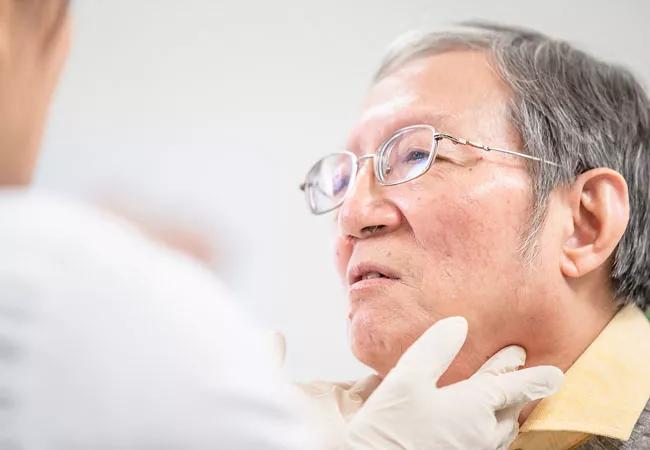Advertisement
Study offers new surveillance guidelines for a rare head and neck tumor

In the largest study of its kind, Cleveland Clinic surgeons published their research in Head & Neck that demonstrates the incidence of second primary paragangliomas in the head and neck and provides new recommendations on clinical surveillance.
Advertisement
Cleveland Clinic is a non-profit academic medical center. Advertising on our site helps support our mission. We do not endorse non-Cleveland Clinic products or services. Policy
Paragangliomas are rare, slow-growing tumors in the neck, chest, abdomen or pelvis that occur in one in 30,000 to 100,000 people. When a patient has one paraganglioma, they are at greater risk for a second. As less than one-fifth of paragangliomas occur in the head and neck, some guidelines recommend as frequent as annual imaging of the chest, abdomen and pelvis to screen for second tumors after a patient has been treated for a paraganglioma of the head and neck.
Kevin Contrera, MD, MPH, a fourth-year resident in Cleveland Clinic’s Head & Neck Institute and first author on the publication, notes that the study was designed to track longitudinal outcomes of second primary paraganglioma.
“There was minimal data on the management of head and neck paragangliomas after treatment, and imaging surveillance guidelines are inconsistent,” he says.
The investigators led a retrospective chart review of patients who had a diagnosis of head and neck paraganglioma, including carotid body tumor, glomus vagale, glomus jugulare and glomus tympanicum, between 1990 and 2010. In a cohort of 234 patients, 14 (6.0%) were found to have a second primary paraganglioma in the head and neck, while only three patients (1.3%) ever developed a second primary tumor outside of the head and neck region.
Advertisement
The incidence of a second paraganglioma in the chest, abdomen or pelvis was 2.59 per 1,000 person years, meaning a patient would, on average, require 380 years of repeat imaging to find one additional paraganglioma. However, patients with hereditary paraganglioma were at nearly five-fold greater risk for developing a second primary tumor (HR [hazard ratio] = 4.84, 95% confidence interval [CI]: 1.52-15.43) as compared to patients with negative or no genetic testing. Patients with carotid body tumors, a type of paraganglioma, were also at a greater risk (HR = 3.55, 95% CI: 1.15-10.99).
Based on these findings, the authors recommend against the use of routine imaging of the chest, abdomen or pelvis for patients without hereditary paraganglioma. Robert Lorenz, MD, MBA, FACS, head and neck surgeon in Cleveland Clinic’s Head & Neck Institute and corresponding author of the study, notes that this offers an evidence-based perspective that may alter practice for physicians following patients with head and neck paragangliomas. “Genetic testing can play a big role in guiding clinical management as imaging outside the neck may be appropriate every several years for patients with hereditary paragangliomas,” he says.
While there are conflicting guidelines from medical associations on how to follow head and neck paraganglioma patients, data from this study directly opposes opinion-based recommendations of the European Society of Endocrinology, which recommends repeated imaging every one to two years for at least 10 years.
“Repeat imaging is not without risks, and should be balanced with potential benefits,” Dr. Contrera notes. “Overexposure to radiation from CT scans can be potentially harmful, while MRIs can be egregiously expensive for patients and healthcare organizations. Not to mention, there is also a psychological component to repeat testing that can create a lot of anxiety for patients.”
The authors note that the frequency of surveillance imaging of the head and neck is multifaceted, but should take recurrence or progression of the primary tumor into consideration. Future studies are needed to validate these findings in a prospective setting and to better understand the genetic characteristics of head and neck paragangliomas.
“In the era of financial stewardship, we hope this research helps shift oncologic surveillance towards evidence-based care,” says Dr. Lorenz.
Advertisement
Advertisement

Polygenic risk score could help predict who will develop this aggressive breast cancer

New guidelines offer insight into emerging therapies, dental issues and more

Clinical trial to assess the value of nutritional, physical therapy and social supports prior to preoperative chemotherapy

Research demonstrates improved overall survival for patients receiving comprehensive treatment for breast cancer in addition to radiation or surgical intervention for brain cancer

Platinum-eligible phase 3 trial of enfortumab vedotin and pembrolizumab yields ‘unprecedented data’

Cleveland Clinic Cancer Institute brings multidisciplinary care, precision oncology and clinical research to the United Arab Emirates

Extent of baseline burden impacts progression-free and overall survival

Further study warranted to better understand the clinical implications of these findings